|
   |
|
Page 6 |
Newsletter 86, Autumn 2009 © Hampshire Mills Group |
|
|
|
Saturday,
13th June was a lovely warm
and sunny day for the HMG Day Trip, this
time to five windmills and one watermill
in Sussex. Andy Fish was our minibus
driver for the day, starting out very
early from Southampton and collecting
members along the way via Winchester and
Emsworth.
First
mill on a packed itinery
was High Salvington Windmill,
just north of Worthing, where we were
greeted by Peter Hill, Chairman of the
Sussex Mills Group (and our excellent
host and leader for the day), plus many
other SMG members. Peter Casebow,
Bob Potts and Roger Ashton guided us
over the mill. Built sometime
before 1750, this black post mill ceased
working by 1900. It has been
restored to full working order and
producing flour. The roundhouse
contains interesting historical
photographs including the stones being
rolled out of the doorway. The
granary has also been restored and is
used for educational (schools) purposes.
|
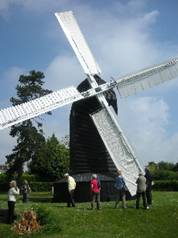
High Salvington |
|
The Glynde Windpump,
remains of which were recovered from a
site close to the railway near Glynde in
1988 where it had originally supplied
water to steam engines, was erected here
in 2006 but in a partially restored
state. Restoration was completed in
2008 in accordance with information and
photographs taken in 1929. A pavilion
houses a shop and a kitchen, all
staffed by ladies who gave us extremely
welcomed refreshments. Our member,
Peter Mobbs, who also belongs to SMG,
joined us here. All of these buildings
stand within a large paddock which
enables the volunteers to stage
fund-raising events such as fetes and
barn dances. |
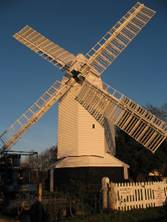
Oldlands Windmill |
|
A
photoshoot only was available for
Polegate Windmill which is now
surrounded by a housing estate.
One pair of sweeps (sails) lay on the
ground waiting to be fitted with the one
pair already aloft. Restored in 1967,
this brick tower mill boasts its
original machinery and three working oat
crushers. A milling museum, education
room and refreshment area are located in
adjacent mill buildings. |
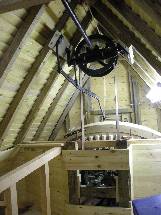
Inside cap at Oldlands Windmill |
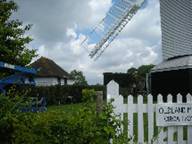
Oldland Granary
|
| Michelham
Priory
afforded
us our only watermill on this trip and
what a sweet one it is too. Located on
the “free” side of the thirteenth
century Priory’s moat, with the car park
alongside, it is easily accessed. Once
powered by two waterwheels in tandem on
the mill’s north side, as depicted on a
carpenter’s drawing dated 1667, there is
now one sited on the south side. It is
thought that the mill race and wheel
were relocated in the nineteenth century
as we see them now. Rebuilt several
times through the centuries, milling
continued until 1924 and a turbine was
installed to provide power to the main
house whilst the mill building was used
as a store, all machinery having been
removed. The Friends of Michelham
Priory took on the task of the derelict
mill’s extensive restoration in 1971 and
the ensuing five years saw them
re-laying the roof with old tiles,
installing a new, wooden waterwheel and
machinery plus a pair of French Burr
stones; local elm was used for a new
main shaft and oak and elm hurst frame.
Operated regularly until 1995, major
restoration was carried out in 1997 and
a new cast iron waterwheel replaced the
wooden one. John Harvey, Roy Tomkies
and Franz Plachy were guides and miller
as well as answering queries and selling
flour to the public. All the volunteers
here are members of Sussex Past/Sussex
Archaeological Society.
www.sussexpast.co.uk/michelham. |
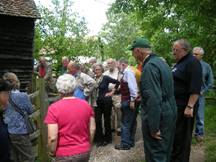
Michelham Priory Mill
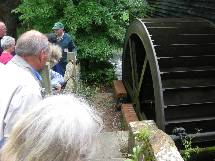
Michelham Priory water wheel |
| Windmill
Hill Windmill
is extra
special as it gives its name to the
settlement around it, is both the
youngest mill and is not only the
largest windmill in the south east but
is also the tallest post mill in the
country; the floor plan measures
6.6metres x 3.73metres (21ft 8ins x 12ft
3ins); height 15.5metres (50ft 10ins).
This mill also houses several unique
features which include an innovative
sweep governor, patented by the miller
at the Clayton Mills, Charles Edwin
Hammond, in 1873 to regulate the speed
of the sails. From our volunteer
guides, Mike Chapman, Maureen Bishop and
Rhys Clatworthy, we went on to learn
that 1814 saw its erection, and so
strongly put together that despite the
1987 hurricane, when another Sussex post
mill succumbed, Windmill Hill Post Mill
stood firmly on its brick foundations
even though it had by then reached a
state of dereliction. Henley-on-Thames
millwrights, IJP Building Conservation
Ltd., had the entire body rebuilt in
their workshop. Restoration was
completed on this Grade 11* listed
building in 2006.
www.windmillhillwindmill.co.uk. |
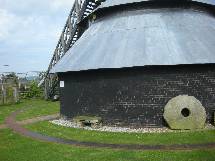
Windmill Hill |
|
Last, but
certainly not least, is the unusual
West Blatchington Smock Windmill
atop its three barns. A splendid tea
was provided here by the smiling and
patient, Sylvia Higgs and Joan Hill.
Another mill surrounded by houses, this
mill was built on a barn complex around
1820 and only worked until 1897. Its
original machinery remains at the heart
of this museum to milling. The main
barn houses an education centre and a
fascinating display of items, many
rescued from other Sussex mills. A
small shop, also surrounded by milling
and farming artefacts is found in a
second barn, whilst the third barn sees
to the more practical needs of visitors
and users of the workshop! We lingered
at West Blatchington, tearing ourselves
away to start the long trip home at
7.30pm.
It
was a very long, very satisfying and
very enjoyable day of meeting many happy
like-minded mills enthusiasts and of
learning the histories and workings of
their very different mills. Peter
Hills organised and orchestrated our
visit superbly and we are all very
grateful to him and all the other Sussex
Mills volunteers many of whom,
incidentally, were smartly attired in
sweatshirts bearing embroidered images
of “their” mills. Pride was reflected
in the clean tidiness of each mill with
work tools stored neatly and safely.
Sussex
Mills Passports:
It’s fun,
particularly for young children, to have
a Sussex Mills Passport to take along to
each mill and get it stamped. Once the
Passport has 12 stamps, it can be sent
in to claim a limited edition silver
coloured Dusty Miller Badge and
a year‘s free newsletters from Sussex
Industrial Archaeology Society (SIAS).
Much
more information on these and all the
other mills in this beautiful county is
available on:
www.sussexmillsgroup.org.uk
Acknowledgements
are due to
members of all the groups mentioned for
written information included in this
report which was compiled by Sheila
Miles Viner who also took the
photographs. |
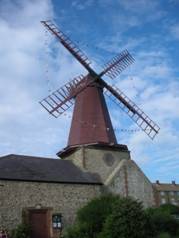
West Blatchington
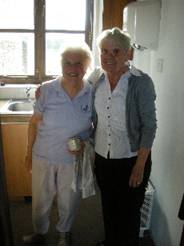
Joan Hill & Sylvia Higgs
The Refreshment Team ! |
  
|
|
